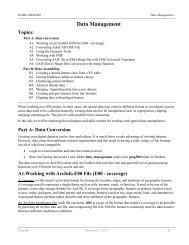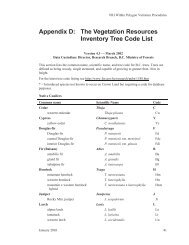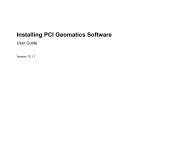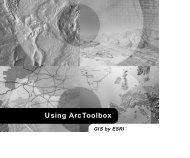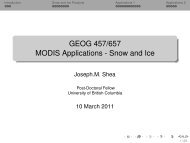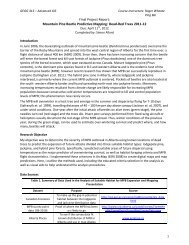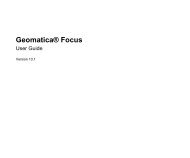Understanding Map Projections
Understanding Map Projections
Understanding Map Projections
You also want an ePaper? Increase the reach of your titles
YUMPU automatically turns print PDFs into web optimized ePapers that Google loves.
equator<br />
The parallel of reference that defines the origin of latitude<br />
values, 0° north or south.<br />
equatorial aspect<br />
A planar projection that has its central point at the<br />
equator.<br />
equidistant projection<br />
A projection that maintains scale along one or more lines<br />
or from one or two points to all other points on the map.<br />
equivalent projection<br />
A projection on which the areas of all regions are shown<br />
in the same proportion to their true areas. Shapes may be<br />
greatly distorted (Snyder and Voxland, 1989). Also known<br />
as an equal-area projection.<br />
false easting<br />
A linear value added to the x-coordinate values, usually to<br />
ensure that all map coordinates are positive. See false<br />
northing.<br />
false northing<br />
A linear value added to the y-coordinate values, usually to<br />
ensure that all map coordinates are positive. See false<br />
easting.<br />
flattening<br />
A measure of how much a spheroid differs from a sphere.<br />
The flattening is the ratio of the semimajor axis minus the<br />
semiminor axis to the semimajor axis. Known as ‘f’ and<br />
often expressed as a ratio. Example: 1/298.3. Also known<br />
as the ellipticity.<br />
Gauss–Krüger<br />
A projected coordinate system used in Europe and Asia<br />
that divides the area into six degreewide zones. Very<br />
similar to the UTM coordinate system.<br />
geocentric latitude<br />
Defined as the angle between the equatorial plane and a<br />
line from a point on the surface to the center of the<br />
sphere or spheroid.<br />
geodesic<br />
The shortest distance between any two points on the<br />
surface of a spheroid. Any two points along a meridian<br />
form a geodesic.<br />
geodetic latitude<br />
Defined as the angle formed by the perpendicular to the<br />
surface at a point and the equatorial plane. On a spheroid,<br />
the perpendicular doesn’t hit the center of the spheroid in<br />
the equatorial plane except at the equator and the poles.<br />
geographic coordinate system<br />
A reference system that uses latitude and longitude to<br />
define the locations of points on the surface of a sphere<br />
or spheroid.<br />
geographic transformation<br />
A method that converts data between two geographic<br />
coordinate systems (datums). Also known as a datum<br />
transformation.<br />
Global Positioning System<br />
A set of satellites operated by the U.S. Department of<br />
Defense. Ground receivers can calculate their location<br />
using information broadcast by the satellites.<br />
GPS<br />
See Global Positioning System.<br />
graticule<br />
A network of lines representing a selection of the earth’s<br />
parallels and meridians (Snyder and Voxland, 1989).<br />
great circle<br />
Any circle on the surface of a sphere formed by the<br />
intersection of the surface with a plane passing through<br />
the center of the sphere. The shortest path between any<br />
two points lies on a great circle and is therefore important<br />
to navigation. All meridians and the equator are great<br />
circles on the earth defined as a sphere (Snyder and<br />
Voxland, 1989).<br />
Greenwich prime meridian<br />
The prime meridian located in Greenwich, England.<br />
grid<br />
A network of lines representing a selection of a projected<br />
coordinate system’s coordinates.<br />
HARN<br />
See High Accuracy Reference Network.<br />
102 • <strong>Understanding</strong> <strong>Map</strong> <strong>Projections</strong>




